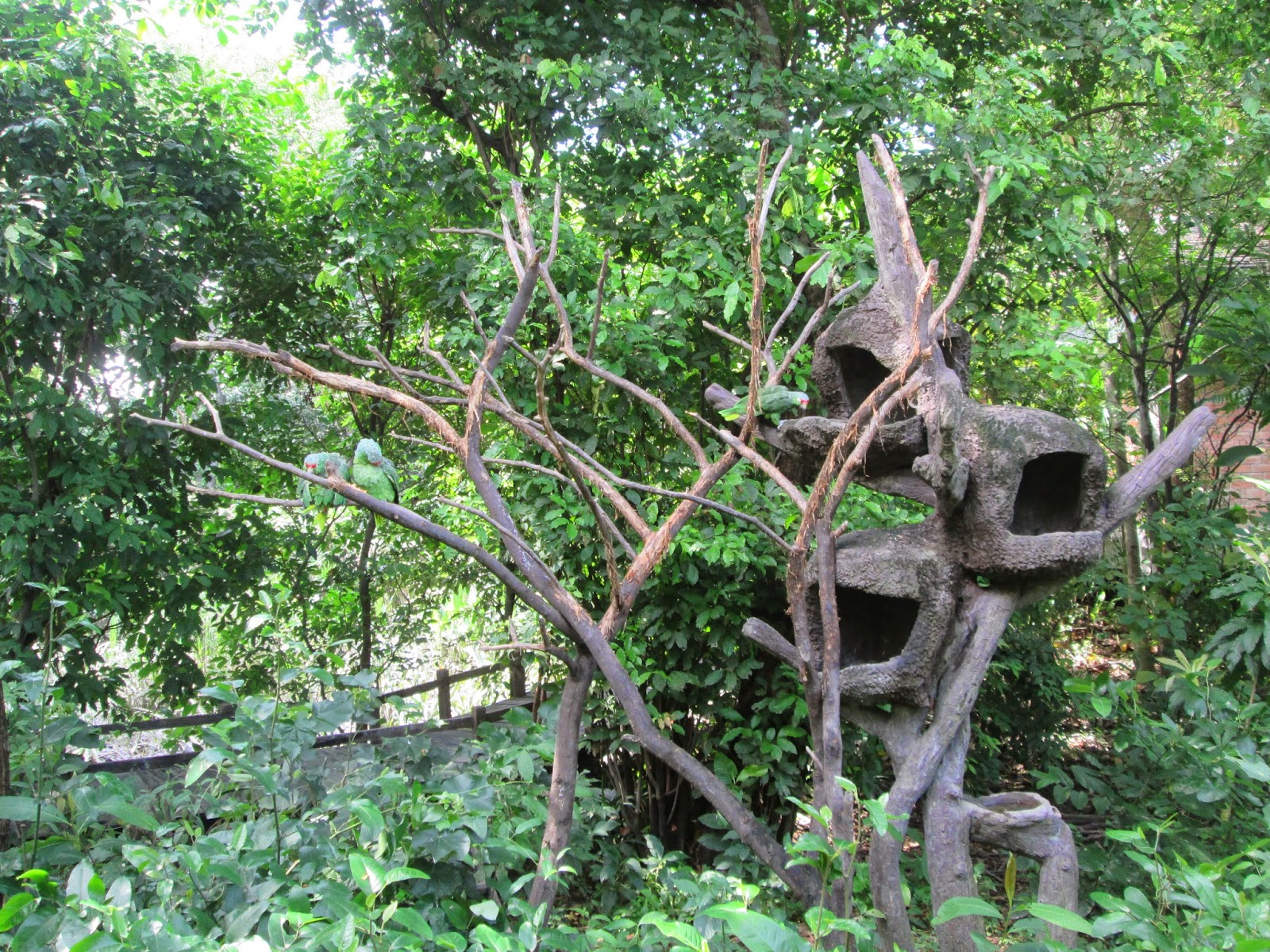When I was in the Galapagos, I brought Douglas Adam's
Last Chance to See along with me. The book details some number of trips he took in the late eighties to see nine charismatic species on the brink of extinction: Aye-ayes of Madagascar, Komodo dragons on the island of Komodo in Indonesia, the Kakapo in New Zealand, Mountain gorillas and the Northern white rhinoceros in Zaire, the Yangtze River Dolphin in China, the Rodrigues fruit bat on the island of Rodrigues, Mauritius (The same island the famed Dodo hailed from), Amazonian manatees in Brazil, and the Juan Fernández Fur seal on the Juan Fernández Islands, Chile. Not only were his journeys a way for him to see these critically endangered species: they were a way for him to travel all over the world and get a feel for what their habitats were like.
Very different, I suppose, than they are today.
I'll admit that a great part of my motivation for travel this year was to establish the most intact 'baseline' I could for Central and South America. For those of you unfamiliar with that terminology, a 'baseline' is roughly defined as the sense of intactness of an ecosystem for the people who experience it. What follows is a concept referred to as a 'shifting baseline': what people consider to be a 'normal' environment or ecosystem is based on their personal experience, and changes with each generation as environments degrade and disappear. If you want to hear more about stories concerning shifting baselines, here's a funky podcast called
'Wild Ones'. I'm glad that I got to establish my baselines for the places I visited in Latin America when I did: they will undoubtedly be very different in ten, fifteen, or twenty years down the road when I can establish myself there to work in conservation for the rest of my life.
Adams is one of my favorite authors. It was fascinating to read about his take on the travel and efforts involved to find and protect these species, especially given his lack of experience in biology. More fascinating, in sometimes heart-breaking, sometimes heart-soaring ways, were the comparisons I was able to draw between the conservation status of these species and their habitats in the eighties and today. The Echo, or Mauritius Parakeet, and the Kakapo are conservation success stories of our age; the Northern white rhinoceros is functionally extinct in the wild, with only three known individuals outside of captivity---seven in total, and only four young enough to breed. It is speculated that this particular species will go the way of one of its brothers: The Western black rhinoceros was declared extinct in 2013.
The last sighting of a Yangtze, or Baiji, River Dolphin was in 2002. Adams couldn't even find one when he visited. The chapter is powerful: Adams and crew go about exploring what sounds polluted the river, as the Baiji dolphin was extremely sensitive to sound and dependent on underwater vocalizations to breed; the river was a screaming static. Boats, industry, and man-made river-walls had drowned out the dolphins.
Adam's stories may focus on these nine charismatic species, but his message and observations go much further: into the past and future of the environment that brought forth these fantastic creatures, which other irreplaceable flora and fauna are at risk, and what our relationship and responsibilities are to these places and animals, as humans and co-habitants of this planet.
Because it's so apropos, I wanted to share the short story Adams shared in the epilogue of his book here on my blog. It's called...
Sifting Through the Embers
by Douglas Adams
There’s a story I heard when I was young that bothered me because I couldn’t understand it. It was many years before I discovered it to be the story of the Sybilline books. By that time all the details of the story had rewritten themselves in my mind, but the essentials were still the same. After a year of exploring some of the endangered environments of the world, I think I finally understand it.
It concerns an ancient city – it doesn’t matter where it was or what it was called. It was a thriving, prosperous city set in the middle of a large plain. One summer, while people of the city were busy thriving and prospering away, a strange old beggar woman arrived at the gates carrying twelve large books, which she offered to sell to them. She said that the books contained all the knowledge and all the wisdom of the world, and that she would let the city have all twelve of them in return for a single sack of gold.
The people of the city thought this was a very funny idea. They said she obviously had no conception of the value of gold and that probably the best thing was for her to go away again.
This she agreed to do, but first she said that she was going to destroy half of the books in front of them. She built a small bonfire, burnt six of the books of all knowledge and all wisdom in the sight of the people of the city, and then went on her way.
Winter came and went, a hard winter, but the city just managed to flourish through it and then, the following summer, the old woman was back.
“Oh, you again,” said the people of the city. “How’s the knowledge and wisdom going?”
“Six books,” she said, “just six left. Half of all the knowledge and wisdom in the world. Once again I am offering to sell them to you.”
“Oh yes?” sniggered the people of the city.
“Only the price has changed.”
“Not surprised.”
“Two sacks of gold.”
“What?”
“Two sacks of gold for the six remaining books of knowledge and wisdom. Take it or leave it.”
“It seems to us,” said the people of the city, “that you can’t be very wise or knowledgeable yourself or you would realise that you can’t just go around quadrupling an already outrageous price in a buyer’s market. If that’s the sort of knowledge and wisdom you’re peddling, then, frankly, you can keep it at any price.”
“Do you want them or not?”
“No.”
“Very well. I will trouble you for a little firewood.”
She built another bonfire and burnt three of the remaining books in front of them and then set off back across the plain.
That night one or two curious people from the city sneaked out and sifted through the embers to see if they could salvage the odd page or two, but the fire had burnt very thoroughly and the old woman had raked the ashes. There was nothing.
Another hard winter took its toll on the city and they had a little trouble with famine and disease, but trade was good and they were in reasonably good shape again by the following summer when, once again, the old woman appeared.
“You’re early this year,” they said to her.
“Less to carry,” she explained, showing them the three books she was still carrying. “A quarter of all the knowledge and wisdom in the world. Do you want it?”
“What’s the price?”
“Four sacks of gold.”
“You’re completely mad, old woman. Apart from anything else, our economy’s going through a bit of a sticky patch at the moment. Sacks of gold are completely out of the question.”
“Firewood, please.”
“Now wait a minute,” said the people of the city, “this isn’t doing anybody any good. We’ve been thinking about all this and we’ve put together a small committee to have a look at these books of yours. Let us evaluate them for a few months, see if they’re worth anything to us, and when you come back next year, perhaps we can put in some kind of a reasonable offer. We are not talking sacks of gold here, though.”
The old woman shook her head. “No,” she said. “Bring me the firewood.”
“It’ll cost you.”
“No matter,” said the woman, with a shrug. “The books will burn quite well by themselves.”
So saying, she set about shredding two of the books into pieces which then burnt easily. She set off swiftly across the plain and left the people of the city to face another year.
She was back in the late spring.
“Just one left,” she said, putting it down on the ground in front of her. “So I was able to bring my own firewood.”
“How much?” said the people of the city.
“Sixteen sacks of gold.”
“We’d only budgeted for eight.”
“Take it or leave it.”
“Wait here.”
The people of the city went off into a huddle and returned half an hour later.
“Sixteen sacks is all we’ve got left,” they pleaded, “times are hard. You must leave us with something.”
The old woman just hummed to herself as she started to pile the kindling together.
“All right!” they cried at last, opened up the gates of the city, and let out two ox carts , each laden with eight sacks of gold. “But it had better be good.”
“Thank you,” said the old woman, “it is. And you should have seen the rest of it.”
She led the two ox carts away across the plain with her, and left the people of the city to survive as best they could with the one remaining twelfth of all the knowledge and wisdom that had been in the world.
________________________
Remember how I talked about the Brazilian Amazon in my
summary post? Between Iquitos, Peru, and Manaus, Brazil--even beyond--you can fly in a plane and see -no trace of man- for many hours, in every direction. We're losing that forest faster and faster with each year that passes; the Western black rhinoceros, the Golden Toad, Hawaiian honeycreeper species; our bees, even. Chytrid fungus is wiping out an unprecedented number of amphibian species, white-nose fungus is killing American bat species, vultures in India have declined to almost 5% of their original population numbers because of poisoning from a commonly employed cattle sedative. Many people are realizing that climate change is the biggest threat facing the planet as we know and love it; we're watching the books burn faster and faster every year.
So. When will we pay up?
What will be our ending balance? Three volumes--two volumes? One volume?
None?
There's a lot of Amazon left. There are many, many species we could still save. And many we have started to. Humans are the most beautifully complex, wildly capable, and fascinating species on this planet; but we're just one of billions. We, unlike many of the others, have the power to care for the world around us. And we should be doing quite a bit more of just that.
 |
| The New Zealand Kakapo. |
Let's start paying up today: we'll cherish the volumes that we've saved tomorrow more than any gold.
Cheers,
Nikki Becich




















































































































































